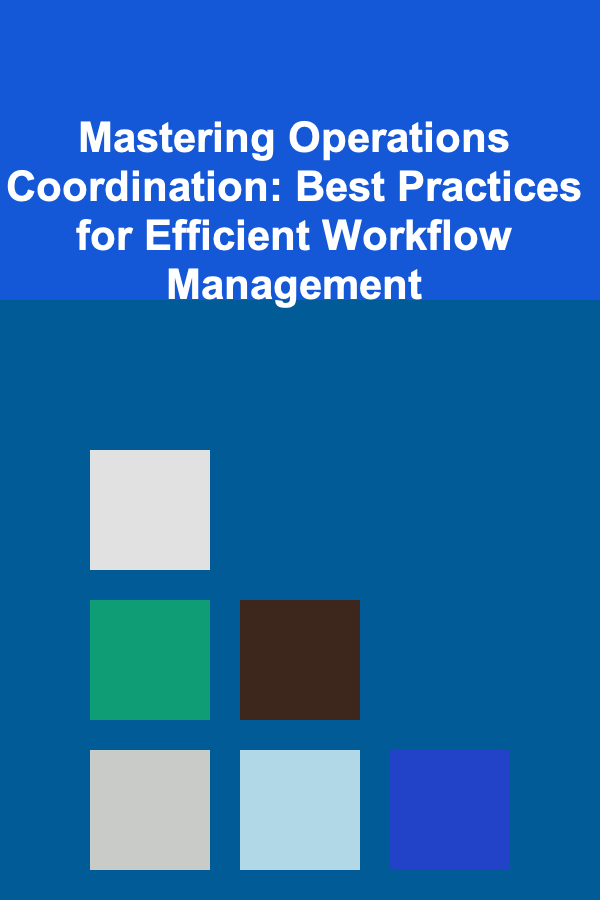
Mastering Operations Coordination: Best Practices for Efficient Workflow Management
ebook include PDF & Audio bundle (Micro Guide)
$12.99$10.99
Limited Time Offer! Order within the next:

In today's fast-paced business world, effective operations coordination is a cornerstone of success. Whether you are managing a small team or overseeing complex organizational processes, the ability to coordinate operations efficiently is key to achieving organizational goals, improving productivity, and delivering excellent customer experiences. However, mastering this skill requires more than just organizing tasks---it involves understanding processes, leveraging technology, and fostering collaboration across departments.
This guide explores actionable best practices for mastering operations coordination, helping you streamline workflows, minimize bottlenecks, and improve efficiency in your organization.
Establish Clear Communication Channels
Communication is the backbone of effective operations coordination. Without clear communication, misunderstandings, misaligned expectations, and errors are inevitable. Establishing clear communication channels is not just about sending messages; it's about creating a system where all team members can access the information they need at the right time.
Best Practices for Communication:
- Centralized Communication Platform: Utilize tools like Slack, Microsoft Teams, or Asana, where all project discussions, updates, and documents are stored in one place. This ensures transparency and keeps everyone on the same page.
- Define Roles and Responsibilities: Clearly communicate each team member's role in the workflow. This avoids confusion and ensures everyone understands their tasks and how they contribute to the larger project.
- Regular Check-ins: Set up daily or weekly meetings to track progress, discuss challenges, and align team efforts. These check-ins can be virtual or in person, depending on your team structure.
- Real-Time Updates: Use collaborative tools that allow for real-time updates on project status. This helps teams respond quickly to any issues and make adjustments when needed.
Map Out and Standardize Workflows
A well-defined workflow is essential for smooth operations. When tasks are performed in an inconsistent or unstructured manner, confusion and inefficiencies follow. Mapping out your processes and standardizing them is crucial for ensuring that everyone knows how things should be done and in what order.
Best Practices for Workflow Mapping:
- Document Every Step: Break down each task or project into smaller steps, and document the sequence in which they should occur. This creates a standardized procedure that all team members can follow.
- Identify Bottlenecks: Map out the entire workflow to identify areas where delays or inefficiencies commonly occur. Once these bottlenecks are recognized, you can implement strategies to minimize or eliminate them.
- Set Clear Deadlines: Establish clear deadlines for each phase of the workflow. This prevents tasks from dragging on and keeps everyone focused on timely delivery.
- Review and Improve Regularly: Regularly assess workflows to ensure they remain relevant and efficient. As business needs change or new tools become available, your workflows should evolve accordingly.
Leverage Technology to Automate Repetitive Tasks
Manual work can slow down operations and introduce human errors. Automating repetitive tasks not only improves efficiency but also frees up valuable time for team members to focus on more strategic tasks. The key is to identify areas where automation can be implemented without compromising quality.
Best Practices for Automation:
- Task Management Tools: Use project management tools like Trello, Monday.com, or Wrike to automate task assignments, track deadlines, and ensure that tasks are completed on time.
- Use Workflow Automation Software: Leverage tools like Zapier or Integromat to automate data transfers between applications. For example, you can automate the process of transferring email inquiries to your customer relationship management (CRM) system.
- Automate Reporting: Use business intelligence (BI) tools to generate reports automatically. This reduces the time spent on manual data collection and allows teams to focus on analyzing and acting upon the insights.
- Integrate Systems: Ensure that all your systems, such as finance, human resources, and customer service, are integrated to automatically share data. This eliminates the need for manual input and ensures accuracy.
Prioritize Tasks Using the Eisenhower Matrix
In any given day, there are numerous tasks to manage. However, not all tasks are of equal importance. To ensure that your team is working on the right things at the right time, it's crucial to prioritize tasks effectively. The Eisenhower Matrix, named after President Dwight D. Eisenhower, is a popular method for prioritization that categorizes tasks into four quadrants based on urgency and importance.
Best Practices for Prioritization:
- Quadrant 1 (Urgent and Important): These tasks need to be tackled immediately. They are often crises or deadlines that cannot be ignored.
- Quadrant 2 (Important but Not Urgent): These tasks contribute to long-term goals and should be planned and scheduled carefully.
- Quadrant 3 (Urgent but Not Important): These tasks demand attention but do not contribute significantly to long-term goals. Delegate these tasks whenever possible.
- Quadrant 4 (Not Urgent and Not Important): These tasks should be minimized or eliminated entirely to prevent time wastage.
By applying this framework to your team's daily operations, you can ensure that time and resources are allocated to the most important tasks, leading to greater efficiency.
Foster Cross-Functional Collaboration
Effective operations coordination is rarely achieved within a siloed department. Most projects require collaboration across multiple functions within an organization. Building strong relationships and establishing smooth communication channels between departments is essential for ensuring that the right people are involved at the right time.
Best Practices for Cross-Functional Collaboration:
- Encourage Open Communication: Foster a culture of open communication between departments by creating joint projects or regular inter-departmental meetings.
- Shared Goals: Align teams by creating shared goals and KPIs that encourage departments to work together. This helps ensure that everyone is working toward the same objectives.
- Cross-Training: Encourage employees to gain an understanding of other departments' workflows and challenges. This improves collaboration and increases empathy between teams.
- Project Liaisons: Appoint project liaisons or coordinators for cross-functional projects. These individuals act as a bridge between departments and ensure that the project runs smoothly.
Monitor and Measure Performance Continuously
The key to improving operations coordination lies in continuous monitoring and measurement. By tracking performance metrics and evaluating processes regularly, you can identify areas of improvement and make data-driven decisions that enhance workflow management.
Best Practices for Monitoring Performance:
- Key Performance Indicators (KPIs): Establish KPIs that measure the effectiveness of your operations. For example, you might track project completion rates, cycle times, or the number of tasks completed per employee.
- Regular Performance Reviews: Schedule performance reviews to evaluate both individual and team performance. Offer constructive feedback and identify areas for improvement.
- Surveys and Feedback: Use surveys or feedback tools to gather insights from team members about the operations process. This helps identify bottlenecks and areas that need attention.
- Continuous Improvement Culture: Implement a continuous improvement process, such as Lean or Six Sigma, to consistently refine and enhance your operations coordination. Encourage your team to identify inefficiencies and propose solutions.
Embrace Flexibility and Adaptability
While workflows and procedures are essential, it's equally important to remain flexible and adaptable to change. The business environment is dynamic, and unexpected challenges can arise at any time. Embracing a mindset of flexibility allows teams to pivot quickly without disrupting the overall flow of operations.
Best Practices for Adaptability:
- Build Contingency Plans: Develop contingency plans to manage disruptions in the workflow. Whether it's a supply chain issue or a sudden staffing shortage, having a plan in place allows teams to respond quickly.
- Encourage Innovation: Foster an environment where employees feel empowered to suggest new methods or technologies to improve workflows. Continuous innovation is key to staying ahead of operational challenges.
- Agile Methodology: Implement an agile approach where possible, especially for complex projects. This allows you to adjust quickly to changes and maintain momentum even when conditions change.
Conclusion
Mastering operations coordination is not a one-time effort, but an ongoing process of refinement and adaptation. By establishing clear communication channels, mapping out workflows, leveraging automation, prioritizing tasks, fostering cross-functional collaboration, monitoring performance, and embracing flexibility, you can significantly enhance your organization's operational efficiency.
As the business landscape continues to evolve, the ability to manage workflows and coordinate operations effectively will be one of the key differentiators between success and failure. By implementing the best practices outlined in this guide, you can ensure that your organization is equipped to handle the complexities of modern operations and remain competitive in a fast-changing world.
Reading More From Our Other Websites
- [Organization Tip 101] How to Maintain Your Outdoor Garden for Year-Round Beauty
- [Personal Financial Planning 101] How to Start Investing with Minimal Risk
- [Home Budget 101] How to Use Coupons and Discount Codes Wisely
- [Organization Tip 101] How to Maintain Your Routine While Preparing to Move
- [Home Staging 101] How to Stage Your Living Room to Maximize Space
- [Scrapbooking Tip 101] Preserving Memories: A Guide to Archiving and Restoring Old Photo Albums
- [Personal Care Tips 101] How to Choose the Best Aftershave for a Smooth Finish
- [Home Family Activity 101] How to Host a Themed Family Movie Night on a Budget
- [Soap Making Tip 101] Best High‑Protein Oatmeal Soap for Athletes' Skin Care
- [Home Soundproofing 101] How to Create a Soundproof Living Room for Entertaining and Relaxation

How to Maintain a Healthy Work-Life Balance While Remote
Read More
How to Organize Fishing Gear for Different Species
Read More
How to Save Money on Taxes Using Simple Strategies
Read More
How To Master Speaking on Camera
Read More
How To Create a Print-Rich Environment at Home
Read More
Developing a Mindful Eating Practice for Weight Loss
Read MoreOther Products

How to Maintain a Healthy Work-Life Balance While Remote
Read More
How to Organize Fishing Gear for Different Species
Read More
How to Save Money on Taxes Using Simple Strategies
Read More
How To Master Speaking on Camera
Read More
How To Create a Print-Rich Environment at Home
Read More